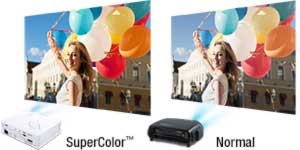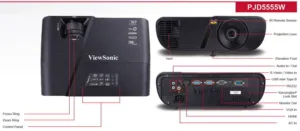At the recent Florida Educational Technology Conference (FETC), January 20 – 23, ViewSonic North America (Brea, CA) introduced a new group of projectors in its PJD6 series of professional projectors targeting the education and other professional markets. These new PJD6 projectors complement the new (and similar) PJD5 projectors introduced at CES 2015 targeting the home market. Collectively, these new additions to the PJD5 and PJD6 series of projectors are called by ViewSonic “LightStream” projectors.

These single panel DLP projectors all have what ViewSonic calls “SuperColor” Technology, as opposed to earlier projectors in the series which only had “BrilliantColor.” In order to find out what SuperColor was, I talked to Jeffrey Hsieh, Product Marketing Manager for Projectors at ViewSonic.
According to Hsieh, the new SuperColor projectors were physically similar to the older BrialliantColor projectors. Both types of projectors had six segment color wheels with red, green, blue, cyan, yellow and white color wheel segments. The improvement in color, he said, comes from the algorithm that decodes the incoming RGB signal into RGBCYW signals to drive the DLP imager during the different color wheel segments. He said the new algorithm puts less emphasis on the white segment and more emphasis on the cyan and yellow segments. Since the white segment provides no color at all and can lead to poor perceived color, Meko believes that reducing the amount of white energy can only improve the system colorimetry. While yellow and cyan can be produced by mixtures of green and red or green and blue in three color projectors, they are important colors in natural imagery. Therefore, emphasizing these colors compared to white also improves colorimetry.
White is added to RGB in single panel projectors to increase total screen brightness when measured with the ANSI luminance measurement. Since yellow is almost as bright as white and cyan is not far behind, de-emphasizing white and increasing the emphasis of yellow and cyan should not seriously affect the total lumen output of the projector. While ViewSonic does not have complete specification sheets for all of its new LightStream projectors, I was given the two they have ready now, for the SVGA (800 x 600) PJD5153 and the WXGA (1280 x 800) PJD5555W. These two projectors both have 3200 lumens output from a 190W lamp in the normal mode. This should be sufficient for the targeted applications, which include home, education and business applications.
The PJD5 series of LightStream projectors includes units with 3000 to 4000 lumens, SVGA, XGA and WXGA resolutions and 15,000:1 dynamic contrast levels. The PJD6 Series of LightStream projectors includes units with 3200 to 3800 lumens, XGA and WXGA resolutions and 15000:1 dynamic contrast.
Lamp life is said to be 5000, 6000 and 8000 hours in the Normal, Eco and Dynamic modes respectively for the PJD5 series. Normal and Eco life is the same in the PJD6 series, Hsieh told me, but Dynamic lamp life is 10,000 hours. Hsieh attributed this improved dynamic life to the fact that the PJD5 series uses an out-sourced lamp power supply but the PJD6 series uses a lamp power supply built in-house and more optimized for the ViewSonic projector. He also told me that the PJD6 series of projectors is slightly larger than the PJD5 series. This allows for larger heat sinks and a larger but quieter fan in the PJD6 series. I suspect this improved thermal performance also contributes to the longer lamp life.
All PJD5 seris projectors have the connectivity shown in the image. The PJD6 series adds two additional connectors: an RJ45 network port and a second HDMI port. This RJ45 port allows education and corporate users to manage their projectors in multiple rooms from a central point. The second HDMI port is also MHL enabled and allows easy connectivity to mobile devices. The PJD6 series also includes a lockable rear cover that both protects the inputs and provides cable control and organization. Another difference between the two series is the PJD5 series includes only vertical keystone correction while the PJD6 series includes both horizontal and vertical keystone correction. All the LightStream projectors are 3D capable, with optional active shutter glasses.
Hsieh says both projector series provide what ViewSonic calls SonicExpert technology. ViewSonic believes that end users are increasingly using the internal speakers in projectors rather than using external speakers. He admitted that in the PJD5 series, with its 2W speaker, the average listener would not be able to tell the difference between SonicExpert and conventional sound technology, although the company has data showing SonicExpert is, in fact, better. He said that with the 10W and 16W speakers in the PJD6 series, the sound improvement from SonicExpert is clearly audible.
At FETC, ViewSonic also introduced the WPG-300 wireless presentation gateway dongle that plugs into an HDMI port. While this dongle can be used in any HDMI port in any ViewSonic display to wirelessly stream video, when it is used in the second HDMI port in the PJD6 series, it can also be used to control the projector over the network. The Wi-Fi dongle will be available in Q2 with an MSRP of $150.
The new LightStream PJD5 Value Series of Projectors include the PJD5153, PJD5555w, PJD5155, PJD5255, PJD5155L, PJD5255L, and PJD5350Ls. All will be available in Q1 2015 with MSRPs ranging from (USD) $399 to $699.
The new LightStream PJD6 Networkable series include the PJD6250L, PJD6350, PJD6355, PJD6550W, PJD6552W, PJD6352LS, and PJD6552LWS. All will be available in Q2 2015 with MSRPs ranging from (USD) $600 to $1000. – Matthew Brennesholtz

